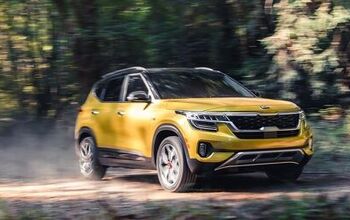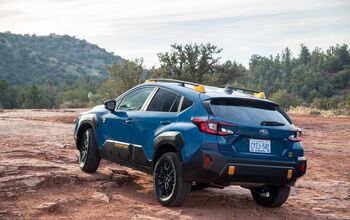Kia Seltos Vs Hyundai Kona: Which Compact Crossover Is Right For You?

Hyundai and Kia, though part of the same umbrella are quite the rivals, especially in the crossover/SUV market.
While both brands mostly utilize the same platforms and powertrains, their products tend to have their own personalities. Be it the K5 and the Sonata or the Palisade and Telluride, which we compared recently.
Get a Quote on a New Kia Seltos or Hyundai KonaToday we are looking at another pair of vehicles from South Korea that have a lot in common except their names. The Hyundai Kona and the Kia Seltos are based on the same Hyundai-Kia B SUV platform but offer distinctly different packages. Where the Kona is a more contemporary take on the compact crossover segment and looks more akin to a car, the Seltos goes for the traditional two-box SUV shape. But which would be a better fit for your daily needs? We compare them to the bones to find out.
Cabin and Cargo Space
Seltos: The more traditional boxy design offers 40 inches of headroom in the front and 38.4 inches in the rear bench. But the sunroof robs the front of 1.5 inches of headroom in the EX and SX trims. Head space at the ear though, remains unaltered.
For your legs, you have 41.4 inches of space up front and 38.0 inches in the rear bench. You also get a shoulder width of 54.7 inches in the rear which is adequate to seat three average-sized adults abreast, even if barely. With the rear bench up, the Seltos can swallow up to 26.6 cu-ft of luggage with ease. Flip the seats down and the capacity increases to 62.8 cu-ft.
Kona: Despite the more crossover or car-eque styling, the Kona offers similar interior dimensions. Legroom in the front, at 41.5 inches is just 0.1 inches more than the Seltos. At the rear, it stands at 37.8 inches, 0.6 inches less than the Seltos.
The styling does hamper the headroom slightly. In the front you get 39.6 inches of head space with the sunroof which drops to 38.0 inches with the glass panel. At the rear, with 37.8 inches of headroom, the Kona is just 0.6 inches shy of the Seltos. As for cargo space, the Kona’s trunk can accommodate 19.2 cu-ft. of luggage, the capacity expands to 45.8 cu-ft with the rear bench folded down.
Bottom Line: Given that, at 172 inches in length and with a 103.4-inch wheelbase, the Seltos offers more space inside the cabin. Plus, the extra dimensions also result in a higher cargo capacity. Hence, it is the winner in this category.
Tech and Features
Seltos: There is no genuine leather or electrically adjustable passenger seat available throughout the range. The leatherette seat trim is only available with the EX and SX trims. A 10-way power-adjustable driver’s perch is also available but again, on the EX and SX trims only. The lower trims make do with a six-way manual setup. A four-way manually adjustable passenger seat however, is standard across the Seltos range.
As for the aircon, there is a choice between the manual and a single-zone climate control only. And you get the climate control with the top two trims only as with most other premium features. An 8.0-inch touchscreen infotainment system with wireless Apple CarPlay and Android Auto is the standard offering, A 10.25-inch system is also available but with the Turbo SX trim only. It is also worth noting here that the SX trim is only available with the turbo engine (more on that later). Also, EX Premium is a Canada specific trim that gets the 10.25-inch UVO screen as well.
SEE ALSO: 2021 Kia Seltos vs 2020 Mazda CX-3 vs 2020 Toyota C-HR ComparisonKia has also introduced a Nightfall edition trim for the Seltos as well. It slots below the top SX trim and skimps on features like LED headlamps, fog lamps and the 7.0-inch digital MID in the instrument cluster but does come with optional 18-inch black alloys and a 10.25-inch UVO touchscreen infotainment system. It also makes do with manual adjustment for the driver’s seat and cloth and leatherette upholstery. Its biggest draw is the fact that it is the only trim apart from the SX to come with the 1.6-liter turbo motor.
Kona: Hyundai offers the Kona with auto headlamps, tilt and telescopic steering and a 4.2-inch digital MID screen as standard. An 8.0-inch touchcreen infotainment system is part of the standard kit and offers wireless Android Auto and Apple CarPlay. Both the SE and SEL trims get manual adjustment for the driver’s seat. An eight-way electrically adjustable driver’s seat is only available on the N Line and Limited trims. The N Line also gets trim specific upholstery and exterior design. You can get the 10.25-inch touchscreen system and wireless charging with the N Line as part of an optional package. Ironically though, the 10.25 -inch screen does not support wireless phone projection.
Features like dual-zone climate control and the premium Harman Kardon speaker system is only available on the N Line and Limited trims. Wireless charging on the other hand, is only available as san optional extra and isn’t available as standard even on the Limited trim. The top trim does however get auto dimming rearview mirror with HomeLink and leather trimmed seats.
Bottom Line: Both the Seltos and Kona offer similar levels of convenience equipment. Even the screen sizes are identical in both crossovers. But where the Seltos offers wireless charging as standard on its top trim, one the Kona it is an optional extra.
Powertrains
Seltos: Kia offers the Seltos with two distinct powertrains. Trims LX and EX are only available with the naturally aspirated 2.0-liter four-cylinder engine cranking out 146 hp of max power and 132 lb-ft of peak torque. The engine hooks up to an “Intelligent Variable Transmission” which is essentially a CVT with mandatory virtual ratios dialed in. Hence, it feels like it has gears but in reality, it’s two cones connected by a belt or a chain.
A 1.6-liter turbo-four is also available but the SX and the new Nightfall trims only. It makes 175 hp of max power and 195 lb-ft of peak torque. It clearly has sporty inclinations as it pairs with a seven-speed dual-clutch transmission. The 1.6 turbo is only available with AWD both in the US and in Canada. You also get paddle shifters if you so feel to take manual control over the shifting. Interestingly, even with the 2.0-liter engine, only the S trim is available with FWD, both the LX and EX trims too are available with AWD only.
Kona: Just like the Seltos, the Kona too is available with the same two engines but with slightly different states of tune. The 2.0-liter engine makes one more horsepower than the Seltos but the same 132 lb-ft of peak torque. In addition, it pairs with the same CVT gearbox with dialed in ratios.
The 1.6-liter turbo-four is also the same as the Seltos but here it makes 20 more horses for a max output of 195 hp and 195 lb-ft of peak torque. Unlike the Seltos, you can have the engine with both FWD and AWD. In addition, both, the N Line and Limited trims are available with FWD and AWD.
Bottom Line: Where the Seltos only offers the S trim with FWD and the 1.6-liter motor with AWD only, the Kona offers both engines with FWD and AWD which will help appeal to a wider audience. Hence it is the winner in this category.
Fuel Economy
Seltos: Being the only FWD trim on the Seltos lineup, the S trim also happens to be the most fuel-efficient. Here, the 2,0-liter four-cylinder motor manages to return 29 mpg of gas mileage in the city, 35 mpg out on the highway for a combined efficiency figure of 31 mpg.
SEE ALSO: 2021 Kia Seltos EX Review: Where Do Its Priorities Lie?The 2.0-liter with AWD on the LX and EX on the other hand, returns 27 mpg in the city, a much lower 31 mpg on the highway, and 29 mpg overall. AWD is available with the S trim as well but the efficiency figures remain unaltered. The sportier 1.6-liter turbo motor returns 25 mpg in the city, 30 out on the highway for an overall figure of 27 mpg.
Kona: While the official website doesn’t state economy figures, the EPA estimates that the 2.0-liter FWD Kona will return 30 mpg in the city, 35 mpg on the highway for a combined figure of 32 mpg. The AWD version of the same engine is less efficient by 2 mpg across the board.
The 1.6-liter turbo FWD can return 29 mpg in the city, 35 on the highway while the overall figure is the same as the bigger engine’s at 32 mpg. As for the AWD version, EPA claims an efficiency figure of 27 mpg in the city 32 mpg on the highway while the overall efficiency stands at 29 mpg.
Bottom Line: Despite being powered by the same two engines, the Kona returns better mileage compared to the Seltos across the board.
Safety
Seltos: Seltos comes with rear camera as standard. Cruise control is standard as well but adaptive cruise control with stop and go is only available with the top SX trim. As is the Highway driving assist. Blind-spot detection and assist with rear cross-traffic alert is available on the EX, SX and Nightfall trims only. However, driver assistance systems like forward collision avoidance with pedestrian detection, lane-keep assist, lane departure warning and lane following assist are all part of the standard kit on the Seltos.
Kona: Just like its cousin, the Hyundai Kona too comes with forward collision-avoidance assist with pedestrian detection, lane- following, and keeping assist as standard. Blind-spot monitoring with rear cross-traffic alert is available SEL trim onwards. If you want the smart cruise control with stop and go and Highway Driving Assist, they are available on the N Line as part of an optional package
Bottom Line: Not only do the Seltos and the Kona offer similar levels of safety and driver assistance systems, but their distribution in the trim lineup is also identical. Hence, this category is a tie.
Styling
Seltos: The Seltos has more traditional SUV-esque shape and lines. While the front is quite unique thanks to the tiger-nose grille and angular headlamps, the tail of the Seltos is ambiguous at best. Following the Seltos in traffic, you could mistake it for practically any other compact crossover if you cover the badge.
In profile, it looks like a small two-box SUV and should strike the fancy of people looking for a more boxy shaped crossover.
Kona: The 2022 facelift of the Kona is quite a departure from the sharp but docile face of the 2020 model. Now its sharp and almost angry while some might call it striking. Also, it features two faces. The regular Kona now features a wider grille with sleeker headlamps and DRLs with the large Hyundai logo as the centerpiece on the hood. The Kona N Line on the other hand features the logo on the grille and also gets a more aggressive hood with air intakes and a two-tier front bumper for added aggression. The Wheel arches are also slightly flared and the wheels too are more ornate.
Bottom Line: One looks a smaller SUV while the other like a large hatchback.
Pricing
Seltos: Kia’s compact crossover starts from $23,665 including destination for the base LX trim and comes with AWD as standard. The S, as we mentioned before is the only FWD trim in the lineup and starts from $23,865. An AWD upgrade will set you back by an additional $1,500. Top of the 2.0-liter engine lineup sits the EX trim which also comes with AWD and starts from $26,965. A newly introduced Nightfall Edition is one of only two trims to be offered with the sportier 1.6-liter motor and a seven-speed DCT. The Nightfall edition starts from $27,865 while the range-topping SX trim is available from $29,165.
Kona: Hyundai offers the 2022 Kona with prices starting from $22,135 for the base SE trim while the SEL starts from $23,935 including destination. Next in the lineup is the N Line trim which comes with its own unique styling and starts from $26,685 for the FWD version. The top Limited trim starts from $29,435. Both the SE and SEL trims employ the 2.0-liter naturally aspirated engine while the N Line and the Limited trims come with the 195 hp 1.6-liter turbo motor. All trims are also available with AWD and the upgrade to all driven wheels costs $1,500 extra.
Bottom Line: Upgrading to AWD from FWD costs the same $1,500 on both crossovers. But the Seltos starts at a lower price point compared to the Kona. In addition, prices for the AWD trims of the Seltos are lower than the FWD trims of the Kona. Taking that into account, the price difference between AWD trims rises to nearly $2,000.
Verdict: Kia Seltos vs Hyundai Kona
The Kia Seltos not only starts at a lower price, it also offers more convenience features as standard. Not to mention, SUV aficionados will also find the squared-off SUV-esque shape more appealing as well. While it is slightly less fuel-efficient but also has a lower starting price. Lastly, it also offers AWD at a lower price point and has a more spacious cabin with a higher cargo capacity as well. Unless you want the extra 20 hp from the Kona and the N Line badge, the Seltos is the ideal family compact crossover.
Become an AutoGuide insider. Get the latest from the automotive world first by subscribing to our newsletter here.

More by Kshitij Sharma













































Comments
Join the conversation
The CVT transmission is boring and unappealing. And the Kona Definitely doesn't handle better then the Setos. Also the Seltos is by far the better looking vehicle.
2 nice options. The Seltos is more traditional (on the outside), the Kona is edgier (my preference) I drove both, and preferred the road feel of the Kona, but rear leg room was awful, the Seltos felt roomier. Both drive trains were lackluster , the 2 litre was downright weak feeling, the turbo was peppier, but the engine and transmission didn't feel synched up, resulting in a jerky takeoff. Both are good value for the money.